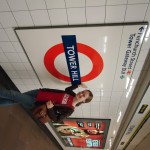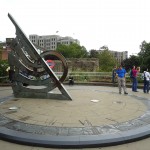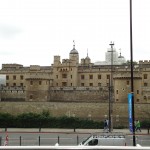Entries Tagged as 'Uncategorized'
August 26th, 2010 · 1 Comment
-
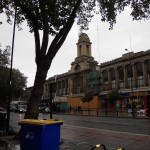
-
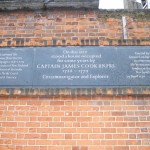
Getting to our stop, once we figured out our route, was a breeze. Jamie and I were eating sandwiches at a local café when we noticed that our stop was mere paces from our eat-bench. We descended into the depths of the tunnel, and Jamie effortlessly passed through the oyster machine. I, however, put my oyster card into the ticket slot and, to the dismay of both the man working the booth and the annoyed Brits behind me, brought the machine to a grinding halt. After being called a foreigner and having my ticket retrieved, we proceeded to our first train, the Northern route. In a paradoxical move, we took the Northern route south to the District route. We had to race up a few flights of stairs and were looking around frantically for the green District route sign when the train dramatically pulled up right in front of us, and took us to our destination.
Our station’s name is Stepney Green, and the reasoning behind the name is rather difficult to decipher. We gathered several bits of information that led us to a couple of theories about why the name is so. The borough name is Stepney, and the station is painted green which would lead to a rather obvious conclusion. We also found out that there is a park called Stepney Green nearby, which could have caused the station to be painted green, providing the station with a fitting and identical name to the park. To determine the true origin of the name will require more research and investigating than our soaking wet, sleep deprived bodies were able to muster.
As we bravely ventured into this so called, Stepney Green, we were bombarded with a crowd of people moving toward unknown destinations at an amazing speed. It made us feel like we were late for something; along with being the only two people completely unprepared for the 30 min long rain showers. After orienting ourselves we began to notice the people on the street and the store fronts along the street. Soon a trend began to form, we had arrived into a town that was predominately Muslim and Indian. The women pushing the strollers on the street were dressed in Burkas. Meanwhile, the shops along the street sold every type of spices necessary to create curries. The town was radically different of what Bloomsburry, where our temporary home the Arrand House is located, looks like.
The question remained as to where were we to find a monument in this maze of Indian store fronts. We walked for five blocks, stopping in store entrances when the rain was unbearable or to seek dosages of caffeine to keep us awake. At the end of five blocks in pouring rain, our stamina was dwindling, we were about to return to the tube when almost magically a monument appeared on the side of the building to our left hand side. The monument was dedicated to Captain James Cook Rivers, whom in 1759 surveyed the St. Lawrence River along with exploring the coasts of Australia New Zealand and the South Pacific in 1769. After making this discovery, we swiftly made our way back to the tube, only to have a close encounter with a bus while crossing the street.
Since it was requested to use an alternative route on our way back, we decided to take the Hammersmith & City( pink) to the Central route (red) getting off on the Tottenham and Court Road exit. After five flights of stairs we were on the street level only to realize all the buildings and stores were unknown. Some sympathetic UK citizens saw our faces of confusion and tiredness and pointed us to the right direction. Home was just two streets over and five blocks away!
Tags: 2010 Jamie · Uncategorized
August 26th, 2010 · 1 Comment
Our destination was the Tower Hll tube Station. Tower Hill is in the borough of the Tower Hamlets, toward the East End of the city. From the hotel, we walked to the Goodge Street Station, located on Tottenham Court Road, and took the black Northern Line to Embankment. From there we took the green District Line to Tower Hill. The tube was not like the subway system that New York City uses. It is cleaner and less noisy. The only people talking on the train were people obviously travelling together or children. Almost none of the riders seemed to be in a rush, but they moved at a consistent, comfortable pace. This first journey took us about 25 minutes.
When we walked above ground at the Tower Hill Station, there were many things that quickly grabbed our attention. Firstly, there was a gigantic sundial. It was a monument. Across the street from the sundial platform, we could see the Tower of London built by the Normans to protect the port of London. Today it houses many exhibits of British history, including the crown jewels. Also located at the Tower Hill station is a piece of the old Roman wall, which marked the original city boundary. On the other side of the sundial platform, there was a monument dedicated to the sailors who sacrificed their lives during World War II.
The sundial has a surprising, almost hidden, meaning. Around the base, where the dial’s shadow casts down, images of London’s history are portrayed. Events such as the founding of the Tower of London in 1066, Shakespeare’s arrival in the city, the Great Fire of 1666, and the Blitz are artistically represented. The sundial is in this location because of all the history that surrounds it. The old Roman wall, the Tower Bridge, and the Tower of London attracts tourists and the sundial is a guide through the different ages of the city. Though initially we did not recognize the images around the sundial’s base, and others seemed to not notice them, people took pictures with the big dial.
Most of the people in this location seemed to be tourists. They interacted with the monuments by taking pictures of them or with them. There was an ice cream vendor on the street that drew groups of parents and children. A sign explaining why scaffolding covered parts of the tower supports the notion that this location is a large tourist attraction. The rest of the people seemed to be people traveling home from work who paid no attention to the monuments.
We took an alternate route home. This time, we traveled from the Tower Hill Station to Monument, where we switched to the red Central Line to take us back to Tottenham Court Road. This journey took us significantly longer, almost 40 minutes. This may have been caused by the start of the evening rush home from work. We noticed a lot more passengers in business dress with briefcases on the journey home. These passengers did not talk much either, but it was clear that they took the same route home routinely every day: they seemed almost robotic. Also, it was a really long walk from when we got off on the platform at Monument to the platform where we could get on the Central Line. We went down two long steep escalators, and back up two long steep escalators. Finally, the Tottenham Court Road Station is farther from Gower Street and the Arran house than Goodge Street Station.
Tags: 2010 David · 2010 Kaitlin · Uncategorized
August 26th, 2010 · 1 Comment
We began our journey with a short walk to the Goodge Street tube station where we proceeded to stand in the station looking around confusedly. Eventually, an employee directed us to take the lift or stairs, “it didn’t matter”. We decided to take the stairs but it turned out to be eight flights in a striped Alice in Wonderland winding staircase. Upon reaching the bottom, we took the Northern Line to Embankment and transfered to the Circle Line to Victoria station, named after Queen Victoria.
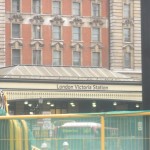
We noticed how clean the tube is, especially compared to the Subway in NYC. As we emerged onto the street, throngs of people hurried around us. Choosing first one direction, then the other, we began walking. Having no better ideas of what to do, when we saw a sign for Buckingham Palace, we headed that way.

We nearly passed the Palace, surprised by how small and under-whelming it is. Continuing to walk, we came to “Little Ben,” a smaller version of the famous London landmark, erected as a sign of Franco-British alliance.
We tried to express to each other exactly what the character of our assigned neighborhood was but found ourselves floundering. Some of the architecture seemed Victorian or even older but an equal amount of the buildings were done in a modernist style. The buildings held everything from restaurants to theatres, and we saw billboards for Wicked and Billie Elliot. The people were likewise a reflection of this confused, or at least blended, character. Walking the streets were people in all styles of clothing, tourists, and people of all races, and ages. It was easy to see why people came to Victoria, it is in the center of the city and has a variety of things to see and do.

By the time we’d walked around for a while, we were hungry and overwhelmed by the number of options and the pace of the people around the Victoria station. We had coffee and then returned to the Arran House, mission accomplished.
Tags: 2010 Daniel · 2010 Melissa · Uncategorized
Ok, so not getting a CRB check was slightly problematic, until Dee, the head of Interface Learning pointed out something rather obvious. It went a little like this.
Dee: Wait, your an international student!
Me: Yes.
Dee: Well than you are an international woman and can come to the International Friendship Group anyways.
Me: Ohhhh…
So, we managed to sidestep that little inconvenience, which just meant that I won’t be able to go into the crèche, which is the children’s playroom. Like that’s a problem for me. It’s really more of a gift, actually. The group gets together once a week, and while the mothers have an English class with a certified English teacher, the children are dropped off in the free childcare. The ladies cook a communal lunch, with everyone taking turns to “host” the meal. Since I couldn’t help with the children I was sort of a gopher by bringing the dishes from storage to the kitchen, etc. It was a lot of fun, and while the younger volunteers I had met at the meeting were very friendly, these women were a lot more reserved and shy with me. It was rather obvious though that many of the women knew each other and spent time together outside of their weekly meeting.
There were a couple teenagers who weren’t in class and they most definitely did not need day care, so they spent the morning in the café with myself, the other volunteers, and Dee. I was amazed by one young woman’s embroidery. She was working on a pillow while waiting for her companion, and the thread that Dee had provided was the same as the kind that I used to make friendship bracelets in summer camp ages ago. When I mentioned that, I was greeted with blank looks from both other volunteers, Louise and Faith. So when I took some of the scraps and showed them what I meant I didn’t realize that I would end up being the referee in their race to start and finish their own bracelets. Unfortunately class ended before a winner could be determined. A small sidenote, I once again had to cross the huge scary roundabout to get to the Children’s Centre, but on the way back Faith taught me a shortcut! No more rotary! Now, I just have to figure out the shortcut in reverse.
Tags: Uncategorized
As a Law and Policy major I have devoted a serious chunk of my college education on the study of government, law, and policy management. Because of this I have seen how a piece of legislation can be traced from the Committees in Congress to the President signing a bill into law, a bill that could later drive a case through the ranks of the judicial system where it can be called into question in front of the Supreme Court, but all of that basically can be boiled down to checks and balances. I also see how issues become a sensation to the media and problems blown way out of proportion, or the focus of the issue is shifted. That was really driven home today when I was in volunteer training at the New Routes Organization. They are part of the greater program called Interface Learning. The program is devoted to long-term integration of refugees in the Norwich area.
During the training the leader of the organization shared some newspaper headlines that read, “Refugees swarm the UK like ants,” and “City Flooded with Immigrants,” as well as several others. The second quote was taken from a Norwich paper immediately after Norwich was opened as an immigration dispersal point in 2003. The first headline was written in 1900. I’m not saying that newspapers are wrong because in the end they are just a company out to make a profit, but often when it comes to immigration we see that they use dehumanizing language to make a terrified refugee out to protect herself and her family into a faceless horde. The majority of immigrants come from wealthy families looking for better opportunities and they do not need to “steal” benefits from hardworking citizens. Two immigrants that I met today were highly trained computer specialists from Iraq looking to contribute to society, and another was trained at an American institute in Kenya. She also probably speaks better English than some of my flatmates. No mumbling!
The UK is home to roughly 0.3% of the world’s refugees since many will flee to no farther than the safest place, an example is that refugees in Africa will often run to other places within the continent because they do not have the money to make it farther than the closest “safe” place. It saddens me that many British, like Americans, cannot see any farther than a newspaper headline to look at some actual statistics. As of last year the biggest refugee population in the UK was from Afghanistan, and the largest population of illegal immigrants? They were from Australia. Overall, I found the five hours of training incredibly interesting and I can’t wait to meet the other volunteers at the monthly meeting!
Tags: Uncategorized
The meeting at New Routes that I went to was pretty surprising. The volunteers I met at the training were largely older people who had been involved with New Routes and Interface before. They were a mix of teachers, career volunteers, and several international students. The volunteers that I met at the monthly meeting were largely part of the Mentor program, and most were my age. Among them were many UEA students who served as mentors, and several mentees also came. What came as a surprise is that Dee was drafting many of the pairs to volunteer together at the Norfolk and Norwich Festival, so they could both have a mentor/mentee meeting and do some extracurricular volunteer work. She also introduced the Voices Program to us, which would be conducted by the BBC. The Program wanted members of New Routes to come and tell their stories on camera. It sounded like the program was focusing on the younger set, but that could just have been because everyone at the meeting was in the teenage age group. After business was wrapped up, the group broke up to have a cup of tea (it was pretty rainy and cold) and have a kibbitz, and they weren’t shy about including me or asking me questions. After some tea and biscuits I braved the rain and cold and safely crossed the Rotary of Doom. Which I actually considered a great accomplishment considering the rotary didn’t have any crosswalks…Hopefully I won’t have to cross it in the dark again!
I’m going to combine my frustration with the CRB check with this entry, since I just found out that the UK couldn’t get enough information on me for the check to come through. I’m not sure how I’m going to get the actual volunteering part done now. Uh oh.
Tags: Uncategorized
Originally, I expected this tour to consist of only a very limited number of people. Maybe it would just be myself and my friend Jimmy, whom I had recruited to join me. This was a rather large worry for me for some reason, maybe I didn’t want to be seen as the dork that I am. But once Jimmy and I had made the trek to the Adam and Eve pub, I began to worry that maybe I had actually gotten the date wrong and there was no tour. We went in and asked the bar tender who assured us that it was in fact still on. Jimmy reasonably asked “how will we know who the tour guide is?” The bar tender literally laughed in our faces and said “you’ll just know”. And he was not wrong. The “Man in Black” was just that, a man in all black with a red tie, skull-topped cane, and top hat. I liked him immediately. After we’d paid, I realized that A LOT more people had joined us. Final head count: 45 people even. 10 kids (8 girls, 2 boys) and about an equal number of adult men and women. This was turning out much, much better than I expected. I was about to begin conducting another interview when I was cut off by the Man in Black who yelled over everyone (direct quote here) “All those who wish to walk the corridor of death, please queue over here”. So Jimmy and I gathered around our tour guide who began the tour by telling us that he himself was a ghost who had died in 1875 (totally cheesy, totally awesome). He also set a few records straight, stating that all of the stories are historically true on this walk and that he himself has sifted through the legends and histories. He also advised us to not harass the ghosts if we happen to “feel” them. (OK…what!?) The Man in Black began the tour by discussing the significance of the Adam and Eve pub which was established in 1549. Essentially this pub is haunted by a General who received a mortal wound near the Great Hospital and was rushed back to the pub where he was pronounced dead shortly thereafter. As a side note: I won’t ruin the tour in case anyone is interested in taking it so if you want to find out just how our General received such a mortal wound, take the tour! Anyways, supposedly there are numerous stories about strange occurrences within the Adam & Eve. Tappings, tugging on hair, blood dripping from the walls, and unnatural cold spells. We then proceeded to walked past Gerald’s Factory located along the river and our tour guide continued to explain the historical significance of the area. As we were standing there along the water one of the girls pointed out a figure in the bushes which turned out to be a really uncoordinated and conspicuous “ghost” who was attempting to hide from us. This marked the beginning of a serious of unfortunate failures from this particular “ghost”. Deciding that his jig was up, he sort of jumped out at us awkwardly and simply walked away. Obviously this little hiccup in the coordinated act even confused the Man in Black, who at this point started laughing.
We continued on to Tombland where enormous holes were dug to place thousands of bodies. There are seven total in Norwich and six are located right in Tombland. Altogether approximately 22,000 corpses were laid to rest there. Tombland was not named for these massive graves however, and it is simply a coincidence that the tombs were placed there. In the medieval time, Tombland was the most open space available within the area to place the bodies. From there we continued to the Cathedral where a few interesting things happened at once. We learned about the various ghosts that haunt that area, and ghost haunting that continued to happen through as recently as 1952. The most important thing to note here, is that each of these stories describes true historical events that have withstood the test of time. They simultaneously encourage people to preserve and invest interest in their own history. So as I was nerding out and thinking about how well all of all of these things tied into my paper, I heard a TERRYFYING scream. And I mean like an ear-splitting, bone chilling, screech. Jimmy jumped about 50 feet in the air and yelled “WHAT THE FU…” We both had gotten entirely surprised by a new “ghost” that was supposed to represent the “girl in grey” who had been sentenced to death by the Bishop. This particular “ghost” had selected Jimmy and I to scare, and she did so skilfully by screaming right behind us. Everyone else laughed, but I think Jimmy might have had a massive heart attack…So anyways the story behind the girl in grey is another incredibly interesting tale, so I’m going to make another shameless plug here and ask you guys to all take the walk with the Man in Black. After that little episode, the Man in Black continued to take us to several other locations with equally interesting stories, which ironically really brings each of the locations to life. As we began to wrap up the tour, which was about 3 hours long, I felt confident in the knowledge that I had acquired to represent Norwich’s ghost stories. If you want to learn more specifically about the history behind each location, then take the tour (or just read my final essay!).
Tags: Maddie · Uncategorized
As I have mentioned before, my paper topic is about the importance and anthropological value that lies unnoticed in the often overlooked history of ghost stories. In order to understand how and why ghost stories are relevant to our understanding of history, I first wanted to ask selected people (those about to embark upon the walking tour downtown that I had yet to take) a few questions that would enable me to sift through the “myths” and misconceptions that revolve around the modern ghost stories. So I constructed a very brief questionnaire for my victims, i mean subjects, to answer. My questions are as follows:
- Why are you taking this tour?
- Why are you interested in this topic?
- How many tours have you been on?
- Why does do you think people are so interested in the supernatural?
- What was the most interesting thing that you have learned while on a ghost tour?
I believed this was long enough to hold their attention, but short enough to not completely bore my subjects. I never expected what would happen next. TO begin, I wanted to start out slowly because I am single-handedly the most awkward human being alive. I chose two older women whom I believed would act a lot like my grandmother…sweet, quiet, and willing to help. Instead, I got Mary and Maud. Both women were grasping enormous pints of ale which led me to believe that they very well could have kicked my ass if I asked the wrong questions. BUT this was research so I worked up my courage, threw out my cigarette and cautiously approached them. My little speech began something like this: (Read extraordinarily quickly) Hi my name is Madeleine and I’m doing some research about the contemporary and historical significance of ghost stories and I was just wondering if I could ask you a few questions….” Maud and Mary just stared at me for a good 10 seconds after I had awkwardly trailed off which sounds like a short amount of time, but think “1 MISS..I..SSI…PI”. Then Maud, the larger one, simply said “right” which I took to indicate her consent and I geared up to proceed. Mary however, began asking me questions instead, including, but not limited to things like: Where abouts are you from? Why are you here? Who are you with? Do you like Norwich? Are the boys friendly? Once I answered all her questions, I think they decided that I was indeed trustworthy and told me “to ask the questions, then.” This is how the conversation went:
Q. So what brings you out here this evening? Why are you taking this tour?
A. (Maud) It’s a lovely evening, we are both on holiday and wanted to do something new every night. (Mary, in agreement) Yes.
Q. Oh yeah? That’s nice, I’m on holiday too. So why are you interested in this ghost tour?
A. (Mary) Simple entertainment. This sort of thing is fun. (Maud, in a feat of uncommon depth) You can learn a lot about the past through these ghosts, can’t you?
Q. (Excitedly) That you can! And that is what my research is all about! So how many other tours have you been on?
A. (Maud) Twice, a couple of years ago. (Mary) Never before, actually.
Q. I only have a few more questions. Why do you think people enjoy these tours?
A. (Maud) Entertainment, belief, interest in the unknown….
Q. All great points! Ok, final question. What was the most interesting thing that you learned on these ghost tours?
A. (Maud…vaguely) I once learned about a guy…(trails off into an unnecessary story that I didn’t even bother to record)
Towards the very end of my interview, they really started to warm up to me and once I’d concluded the interview altogether, Maud wanted to discuss some irrelevant things such as where I could find the nearest medium to communicate with the dead. I attempted to sidestep this subject in the vain hopes to interview more people, but the two women were extremely persistent and they continued to talk to me. This sort of ruined my plans of interviewing other people, so I decided to just settle by returning the following Thursday to take both the tour, and interview others. In the mean time, I had to put up with Maud and Mary would spent a good 45 minutes talking to me before the tour started (they had two more beers in that amount of time, by the way). I decided to bow out when I could feel the more people start to queue up for the tour and I thanked both Maud and Mary for being more than willing participants in my survey. As I was walking back to the city centre, I briefly reflected on the interview. Despite being extraordinarily gregarious, Maud and Mary supplied good answers to my questions and not only that, but their desire to walk the ghost tour that day proved something to me. Ghost stories are important in contemporary culture because they create a link, a bridge from the present to the past that reveals an unparalleled insight into the nature of humanity. Ghost stories depict class segregation, lost love, murder, religious tumult, the corruption of political power…all subjects that we can identify with even now. One doesn’t have to be a believer or a non-believer to understand that something else is going on here, something much deeper than most people (including myself) previously thought. Supernatural folklore ties the past into the present. I mean, why exactly do all legends of ghosts depict pain, suffering, and social unrest? Not to sound potentially pessimistic, but I think that this somehow proves that the only constant throughout history is human suffering. These stories provide glimpses into the painful past of our ancestors, and perhaps attempt to teach us about ourselves and what could potentially be at stake if we become too wrapped up in power (religiously, politically, monetarily). I’m really looking forward to the Norwich ghost tour next week now, I’m excited to see if I can prove my theory by actually taking the walk.
Tags: Maddie · Uncategorized
As a brief interlude before my series of blogs begin: I recognize that I haven’t posted these in a timely fashion, but nevertheless they chronicle my experiences in consecutive order. Enjoy!
Well it’s Thursday, April 8th and I am about to embark on a very interesting tour. A ghost tour in fact, through our beloved Norwich. To catch everyone up to speed, my paper topic delves into the history and anthropological value that ghost stories have had on the past and how these stories are translated into our modern culture. In my research and experiential learning, I myself was surprised to see how the evolutions of politics, religion, and class distinctions have evolved in such stories throughout the centuries. Therefore, this evening, I’m attempting to find my way to the Adam and Eve pub where my ghost tour begins at 7:30 pm. I have no idea what to expect, though at least I know the mapping of the tour. We begin by meeting at the Adam and Eve pub, (probably Norwich’s oldest pub as we all know) and proceeding up towards Tombland before heading toward The Whiffler Theatre which apparently was the site of many executions at the Castle Gates. We go back through the Cathedral grounds to Bishop’s Bridge and the Cow Tower before returning for “our finale back at the Adam and Eve” pub. The women I spoke to over the phone assured me that it would be a very interesting walk, and “lots of fun”. My initial response to this was one of indignation; “well it better be worth it because I’m paying six quid for this which COULD have been better spent on quite a few cans of vegetable curry.” The website assured me that “on this walk you will hear about cannibalism, wife murder, lots of witches and lollards not to mention the ghosts of plague victims buried in communal graves without name or ceremony (always a good source of spirit behaviour).” Well, I’m always up for hearing about a little cannibalism and hopefully myriad wife murders so I’m thinking that this tour should be very informative and hopefully an entertaining experience.
I myself have never been on a ghost tour, nor do I really believe in ghosts. In fact, the first time that I actually first encountered someone who truly believed in the existence of such spectral badasses was our very own Anya Settle who is convinced that her room here at UEA is haunted. Not to get briefly off topic, but I had a conversation in Starbucks recently about Anya’s ghostly fears, and Andrew Barron just looked at Anya sceptically and said, “Your room is NOT haunted Anya”. Anya hesitated for a moment, and said, “you don’t have to SLEEP there Barron”. So I guess that puts Barron and I into the “non-believers” category and Anya into the “believers” one…but ultimately it’s not really about truly believing in the existence of ghosts, it’s about what historical value can be discovered from these legends and what hidden cultural significance lies within these oral stories. I’m hoping that this tour will aid in my understanding of Norwich’s history and not simply be some silly tour meant to frighten 6-7 year old girls; I want to extract the deeper essence that brings past societies and ideals back to life. Lastly, if any of you have an interest in watching a brief clip from the tour guide himself without paying the 6 quid, here is a link http://www.youtube.com/watch?v=j1rDNQbo5x8. For now, I’m off to walk the loop around Norwich!
Tags: Maddie · Uncategorized
April 19th, 2010 · 1 Comment

“In every community there is work to be done. In every nation, there are wounds to heal.”
Our communities, the ecosystems of our society, the summation of individuals is often confronted with major challenges, and no communal struggle can be measured and compared; Norwich is no different from New York City. Essentially, the differences between the two are countless, yet there is one particular similarity regarding community sustainability worth looking at. Walking through both cities it is hard to miss the sight of kids/teenagers ages 13-17 roaming the streets, gathering in corners and ‘disturbing the community’ (it would be unreasonable to assume every group of kids, usually boys, is out to cause trouble, but I am referencing a particular segment of the population who clearly is). As I walked to meet with my mentee I came across this group of kids in Norwich, and as an aspiring educator my first thought was: “why are they not in school right now?”That day, my mentee and I had one of the most profound conversations, afterall, we both found ourselves bound by a common issue within our individual communities (across the world): “little gangsters.”
We both agreed that every community, regardless of its geographical placement, is injured by social diseases, which more than often includes child poverty— leading to violence and crime. My mentee, shared some of his own experiential knowledge with me regarding these kids. He claims that there is a particular group of them who sell drugs for an older (possibly adult) guy, afterall, the police would never stop a 13 year old for selling drugs. He claims they work with a “wanna-be gangster mentality,” meaning they are attempting to become the future leaders of gangs, the ‘kings’ of the drug industry: the next statistic of “ethnic minorities” who fail the system. Yet according to the news, crime rates are continuing to drop in the city of Norwich.
According to Ben Kendall, in his article titled “Big fall in Norwich crime rates,” from the Norwich Evening News “Almost 2,000 fewer crimes were committed in Norwich during the past year as police recorded significant reductions in burglaries, violent offences and anti-social behaviour.” The Latest figures show that during the last three months:
~Burglaries fell by 12.5% compared to the last period last year.
~Violent crime fell by 14.6% across Norwich and by more than 30pc in city centre areas including Prince of Wales Road.
~Robberies fell by 19%, vehicle crime by 4% and anti-social behaviour by 19%.
Norwich’s poorest areas are experiencing what is left of crime, as city officials claim to be having a solid impact on the recent decrease, there is still a wound too deep to ignore and not easy enough to heal. My mentee suggests, just how there are multiple programs instituted in order to aid refugees and asylum seekers both integrate and progress in British society and most especifically in the city of Norwich, there needs to be an increase int he number of organizations triggering the “little gangsters” populations. Although there is somewhat of an overlapping between the population of refugees and that of kids on the streets, the target needs to be set clear in oder to help all kids to stay away from drugs, crime and violence.
Joining together as individual parts of a community we can work together to heal the wounds that inflict the future welfare of everyone who is a part of it; my mentee understands this. As a part of the Norwich community he assures me he has and will continue to act as a part of the movement for change, ‘getting kids off the streets is going to be hard’ he says, but in response I suggest “no one said it would be easy.” (My mentee claims our program director, as well as the kid’s parents would never believe it if they knew what their children are doing on the streets, so he is fixed on not telling; I disagreed, but he has asked me to keep to not tell).
Tags: Flow · Uncategorized



